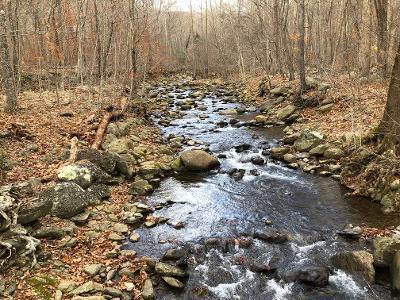This week’s heavy rain caused flooding in areas where streams are blocked by rocks, leaves and tree limbs. Those barriers are an inconvenience for people, but they’re threatening the survival of another species beloved here in Virginia. Sandy Hausman reports on a team effort to save our brook trout.
Claire Catlett says she’s got the best job in the world – wading into Virginia streams on behalf of the Piedmont Environmental Council.
“As you walk in the creek, you’re able to catch the fish in your nets and put them in buckets,” she explains. “If there are enough young fish, it shows us that they are reproducing. We also want to see the bigger fish, because that means this habitat is suitable for longer lifespans.”
For months now, she and her colleagues have been counting, measuring and assessing the health of colorful brook trout and American shad — to find out if manmade bridges and culverts are causing a build-up of rock and soil — keeping fish from swimming upstream to lay their eggs.
“The job of a river is to move the mountains to the sea, and often we forget that until there’s a big flood and we say, ‘Wow, that’s a lot of mountain!’ The sediment and debris gets stuck behind these culverts, which are just under-designed. A lot of them were never meant to carry the kinds of floods we’re seeing these days.”
These barriers are just one of many problems faced by trout. The Piedmont Environmental Council’s Celia Vuocolo says farming and mining have polluted our creeks. Trees were cut down, and water is getting warmer. As a result, brook trout are dying out.
“They’re a species that needs cold, clean water – no warmer than 68 degrees. They really prefer it more in the low to mid 60’s, and they’re very susceptible to any sort of pollution increase. It affects them and stream bugs they rely on for food.”
That may explain the decline in what Vuocolo says is this region’s stronghold for trout – Virginia and the Shenandoah National Park.
“They’re found in Georgia and South Carolina and North Carolina, but we’re really the ones that have the best intact habitat. We’ve lost probably 38% of their range, and what’s left are these really isolated stream pockets. The park has long been kind of a refuge for trout in our region, but their populations are declining even within the park.”
So she, Catlett and others surveyed 141 sites in Albemarle, Greene, Rappahannock and Madison Counties – and in most they found bridges and culverts creating problems. Half of them are on private property. The Virginia Department of Transportation owns the rest. That’s good news, because VDOT is anxious to repair and replace its creekside structures in ways that protect wildlife.
“They’ve been really enthusiastic and interested in learning what they can do to repair or replace crossings that are causing issues for both people and fish,” Vuocolo says.
A non-profit group known as Trout Unlimited has also lent support. Vuocolo says anglers are anxious to protect the fish that make them happiest.
“Trout fishing is a great business, and fly fishing nationally is on the rise, so these natural resources that these local counties have are more important than ever. Expanding trout habitat opportunities to fish is really in these rural counties.”
Joining the stream restoration effort — U.S. Fish and Wildlife Service, the park, the Virginia Department of Wildlife, several foundations and private land owners who will find it easier to access their properties if stream crossings are not clogged and flooded.
***Editor’s Note: The Piedmont Environmental Council is a financial supporter of Radio IQ.
Credit: Source link































